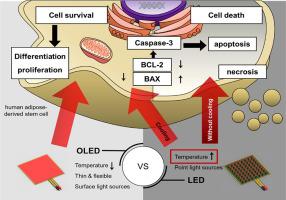Journal of Industrial and Engineering Chemistry ( IF 6.1 ) Pub Date : 2021-07-30 , DOI: 10.1016/j.jiec.2021.07.040 Yu-Jin Kim 1 , Sung-Won Kim 1 , Ju-Ro Lee 2 , Soong Ho Um 1 , Yoon Ki Joung 2, 3 , Suk Ho Bhang 1

|
Light has attracted significant attention as a promising tool in the biomedical and cosmetic industries. However, little is known about the cytotoxic effects of conventional light sources based on their physical effects such as temperature and luminance. Here, the cytotoxic effects of representative light sources, a light-emitting diode (LED) and an organic light-emitting diode (OLED), were studied with human adipose-derived stem cells (hADSCs). Regardless of the identical light energy conditions, LED group induced a higher apoptotic activity in hADSCs than the OLED group due to its significant heat generation compared to OLED as further demonstrated with heat shock protein family gene expression. Additionally, we further confirmed the effect of luminance by irradiating light from LED and OLED under the same temperature and energy conditions. Increased cell proliferation was confirmed in the OLED group, and a significant expression of intracellular reactive oxygen species was observed in the LED group without showing heat shock protein upregulation. Taken together, the differences in cytotoxicity and cellular response after LED irradiation compared with OLED irradiation can be varied with temperature and luminance control. This study suggests that OLED based device could be an alternative and promising light source for future biomedical and cosmetic applications.
中文翻译:

比较基于发光和有机发光二极管的光疗法对人体脂肪干细胞的细胞毒作用
光作为生物医学和化妆品行业中一种很有前途的工具,已经引起了极大的关注。然而,基于温度和亮度等物理效应的传统光源的细胞毒性效应知之甚少。在这里,代表性光源、发光二极管 (LED) 和有机发光二极管 (OLED) 的细胞毒性作用用人脂肪干细胞 (hADSCs) 进行了研究。无论相同的光能条件如何,与 OLED 相比,LED 组在 hADSCs 中诱导的凋亡活性高于 OLED 组,这是因为与 OLED 相比,它产生了显着的热量,热休克蛋白家族基因表达进一步证明了这一点。此外,我们通过在相同的温度和能量条件下照射来自 LED 和 OLED 的光,进一步证实了亮度的影响。在 OLED 组中证实细胞增殖增加,在 LED 组中观察到细胞内活性氧的显着表达,而没有显示热休克蛋白上调。综上所述,与 OLED 照射相比,LED 照射后的细胞毒性和细胞反应的差异可随温度和亮度控制而变化。这项研究表明,基于 OLED 的设备可能是未来生物医学和化妆品应用的替代和有前途的光源。与 OLED 照射相比,LED 照射后的细胞毒性和细胞反应的差异可随温度和亮度控制而变化。这项研究表明,基于 OLED 的设备可能是未来生物医学和化妆品应用的替代和有前途的光源。与 OLED 照射相比,LED 照射后的细胞毒性和细胞反应的差异可随温度和亮度控制而变化。这项研究表明,基于 OLED 的设备可能是未来生物医学和化妆品应用的替代和有前途的光源。


























 京公网安备 11010802027423号
京公网安备 11010802027423号